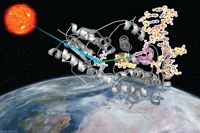
Biomedical Research Center/FB15, Philipps University, Hans-Meerwein-Straße, 35043 Marburg, Germany
e-mail: essen@chemie.uni-marburg.de

 |
Lars-Oliver Essen
Biomedical Research Center/FB15, Philipps University, Hans-Meerwein-Straße, 35043 Marburg, Germany e-mail: essen@chemie.uni-marburg.de |
 |
DNA photolyases are extremely efficient light-driven DNA repair enzymes, which utilize light of the same wavelength range that causes the genome-damaging UV-lesions in need of repair. Apart from a few exceptions these enzymes occur in organisms exposed to sunlight. Their catalytic mechanism employs light-driven injection of an electron from a fully reduced flavin cofactor (FADH-) onto the DNA lesion to trigger cleavage of cyclobutane-pyrimidine dimers (CPD) or 6-4 photoproducts inside UV-damaged duplex DNA.
Recombinant DNA photolyases have a biotechnological potential either for the generation of highly UV-resistant organisms or, in human health, for skin cancer prevention by their ectopical application. Apart from some niche products, these applications have not yet been realized. One major issue is lack of repair activity, because the FADH- cofactor (λmax 300 nm) restricts the action spectra to the near UV. Therefore, many natural photolyases harbor antenna chromophores for broadening their activity spectra (λmax 380-420 nm), but the chemical nature of these antennas is often still unknown.
During the last few years we characterized the structures of several CPD photolyases and related cryptochromes. These photoreceptors can bind antenna chromophores of different chemical nature (MTHF, FMN, FAD, 8-HDF, Dimethyl-ribityl-lumazin) either in a cleft specific for folates or in a pocket within the N-terminal domain specific for (deaza)flavins. Synthetic chromophores can be reconstituted into photolyases at the (deaza)flavins sites using either analogous structures like 8-iodoriboflavin (Thermus thermophilus) or non-analogous structures like 2,6-naphthylene-dicarboxylate (Methanosarcina mazei, MmPHL). Furthermore, we found that class II photolyases like MmPHL, which closely resemble plant photolyases, depend on 8-hydroxy-deazaflavin. The establishment of biosynthetic pathways for these cofactors allows now producing recombinant photolyases with their cognate antenna-chromophores. Overall, these results show that reengineering of photolyases with artificial cofactors is a feasible perspective for enhancing their DNA-repair capacity.